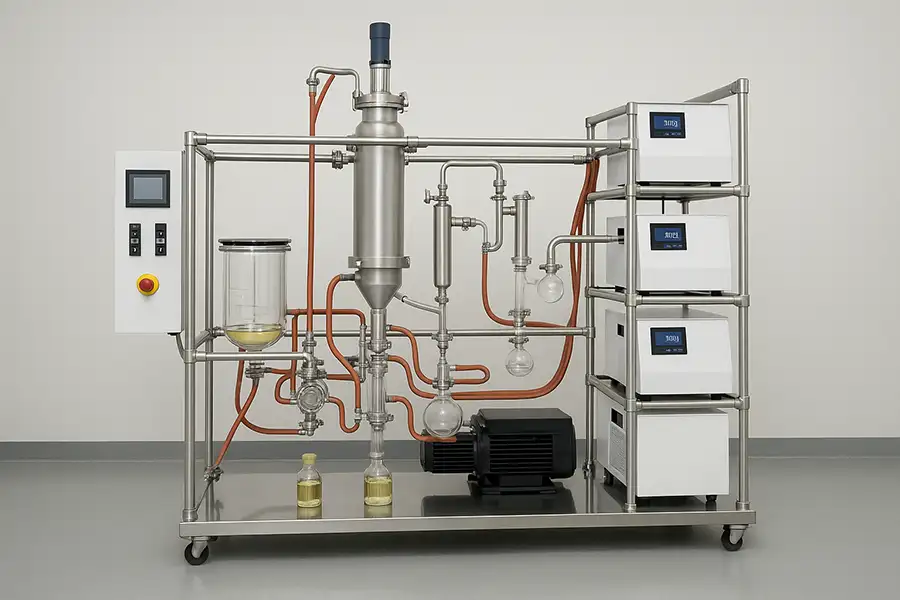Wiped Film vs Falling Film Evaporators
A comprehensive, data-driven comparison guide for chemical engineers, extractors, and processors working with advanced evaporation technology.
In chemical processing, food refinement, bio-pharmaceuticals, and cannabinoid extraction, separating volatile components quickly and gently is mission-critical. Choosing the wrong evaporator can mean higher degradation rates, lower yields, and wasted energy.
Two designs dominate continuous thin-film evaporation today:
Wiped Film Evaporator (WFE) - The high-precision solution for challenging applications
Falling Film Evaporator (FFE) - The efficient workhorse for bulk processing
By the end of this guide, you'll understand:

Wiped Film Evaporator (WFE)
A vertical cylindrical body with an internal rotating wiper system that continuously distributes feed into an ultra-thin film (<0.5 mm). The film spirals downward while wipers refresh the surface, preventing hot spots and fouling.
Operating vacuum: Down to 0.001 mbar
Highly customizable blade configurations
Ideal for viscous, temperature-sensitive materials
Falling Film Evaporator (FFE)
A vertical bundle of heating tubes where feed enters at the top and flows downward along inner tube walls by gravity only. Vapor forms within the same tube bundle.
Higher operating pressures: 10-200 mbar
No moving parts inside the tube bundle
Cost-effective for large-volume, simple applications
| Parameter | Wiped Film Evaporator | Falling Film Evaporator |
|---|---|---|
| Film Thickness | 0.1–0.5 mm (adjustable) | 0.3–1.0 mm (gravity-driven) |
| Viscosity Range | Up to 50,000 cP at 100 °C | Typically <1,000 cP |
| Residence Time | 1–10 seconds | 10–60 seconds |
| Temp-Sensitive Products | Excellent | Moderate |
| Vacuum Capability | 0.001–10 mbar | 10–200 mbar |
| Mechanical Complexity | High (rotor, mechanical seal) | Low (no moving parts) |
| Capital Cost | Higher, but coming down | Lower for same throughput |
Consider cannabinoid purification: distillate viscosity of ~10,000 cP at 60°C is beyond an FFE's capability. A wiped film evaporator handles this with shear-thinning from wiper blades.
Answer:The liquid fails to form a uniform film, creating dry spots and "hot zones" which lead to polymerization, fouling, and eventual tube blockage. Throughput decreases while cleaning frequency increases.
This pattern repeats with thermo-sensitive materials like APIs, essential oils, and vitamin concentrates. Research shows up to 25% higher carotenoid retention in WFE vs FFE (Journal of Food Engineering, Vol 255, 2023), primarily due to shorter exposure times.
Performance Comparison
Thermal Preservation
WFE: 93% retention vs FFE: 71% retentionOperational Viscosity
WFE: Up to 50,000 cP vs FFE: <1,000 cPMaintenance Frequency
WFE: Quarterly deep cleans vs FFE: Monthly cleaningEnergy Efficiency
WFE: 2.8 MJ/kg vs FFE: 3.2 MJ/kgWhile multiple-effect FFE systems are marketed as the most energy-efficient option, Fraunhofer Institute research shows that single-stage WFE with vapor recompression matches three-effect FFE efficiency when processing specialty lipids:
GreenLeaf Botanicals Case Study
ROI After Upgrade
Colorado hemp processor upgraded from 200 L/h falling film to 0.8 m² wiped film system
With global energy fluctuations and tightening carbon regulations, the ability to integrate WFE with heat pumps and closed-loop chillers becomes a significant advantage.
Dr. Elena Rodriguez Sustainability Director, Fraunhofer Institute
| Application Factors | Wiped Film (WFE) | Falling Film (FFE) | Recommendation |
|---|---|---|---|
| Cannabinoid Distillation | Excellent | Poor | WFE strongly recommended |
| Vitamin Concentration | Better | Possible | WFE for higher quality output |
| Desalination Brines | Adequate | Excellent | FFE preferred for cost efficiency |
| High Viscosity Polymers | Ideal | Not Recommended | WFE only viable solution |
| Volatile Citrus Oils | Ideal | Possible | WFE for superior product quality |
Key Takeaways
For high-viscosity, high-value or temperature-sensitive materials, WFE is the superior choice despite higher initial cost.
FFE retains benefits for large-volume, low-viscosity applications and capital-sensitive projects.
Recent innovation in WFE mechanical seals and automation has significantly reduced operational complexity.
Answer:With modern PLC controls and intuitive interfaces, technicians familiar with rotary evaporation typically learn WFE operation in under one week. Most manufacturers offer onsite support to accelerate transition.
